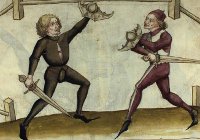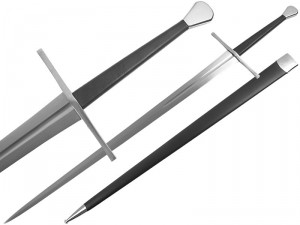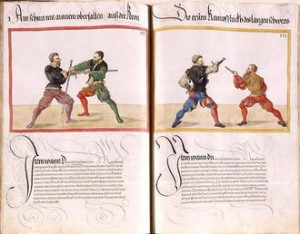Western Martial Arts
 When we hear the words “Martial arts”, generally the first disciplines that come to our mind are probably Judo, Karatedo, Iaido, Kendo, Jodo, Jujutsu, Aikido, Kung fu and many others mostly related to Asia. I guess most of us are aware of the Asian martial arts richness but what about Western martial arts ? Are they still practised today ? what historical material/knowledge are they based on ? what weapons, sword types and techniques are used ?
When we hear the words “Martial arts”, generally the first disciplines that come to our mind are probably Judo, Karatedo, Iaido, Kendo, Jodo, Jujutsu, Aikido, Kung fu and many others mostly related to Asia. I guess most of us are aware of the Asian martial arts richness but what about Western martial arts ? Are they still practised today ? what historical material/knowledge are they based on ? what weapons, sword types and techniques are used ?
![]() Curious and passionate about everything related to fencing, swords and martial techniques in general. I googled in search of information related to European middle ages martial arts. Mainly focusing on the golden age of sword fighting in Europe roughly covering a period between 1250 to 1650. Why not later ? Well, mainly because after 1650 the Flintlock musket became the mainstay of European armies. However, the sword kept his “noble weapon” status and was used during close combat and in judicial duel until mid 19c.
Curious and passionate about everything related to fencing, swords and martial techniques in general. I googled in search of information related to European middle ages martial arts. Mainly focusing on the golden age of sword fighting in Europe roughly covering a period between 1250 to 1650. Why not later ? Well, mainly because after 1650 the Flintlock musket became the mainstay of European armies. However, the sword kept his “noble weapon” status and was used during close combat and in judicial duel until mid 19c.
Period
Let’s go back to the end of the middle ages and the Renaissance period (1455-1688). “Western martial arts” also referred as HEMA – Historical European martial arts involve techniques covering many weapons such as: dagger/knives, blunt/cleaving weapons, polearm, swords, buckler, shield and ranged weapons. There was a continuous research and development to improve weapons efficiency throughout the centuries. But for any knight/soldier of this period the longsword stayed the weapon of choice for more than three centuries.
The longsword
 The longsword was largely used between 1350-1550 with early and late use reaching into the 13th and 17th centuries. It has a straight double-edged blade with a long cruciform hilts and a grips over 15 cm. Its length slightly changed throughout time and had an average 81cm during the 14c to 95cm in the early 16c. Those sword were either considered as half and a half sword or for special long sword “two hands” swords such as the Scottish claymore 105cm and the German zweihänder up to 125cm. Many would think that those sword were heavy, but in reality they weighing between 1.2 and 2.0 kg for the heaviest and longer models. The typical blade that are showed in fencing manual were generally model of 90cm bade length and 1.5 kg. Longswords were used for hewing, slicing, and stabbing. Longsword were maybe not as sharp as Japanese katana but had the benefits of a doubled-edged blade. Their relative sharpness (and maybe the combined usage of leather gloves) allows them to be used during close combat with one hand gripping the blade, being then able to stab the enemy like with a spear.
The longsword was largely used between 1350-1550 with early and late use reaching into the 13th and 17th centuries. It has a straight double-edged blade with a long cruciform hilts and a grips over 15 cm. Its length slightly changed throughout time and had an average 81cm during the 14c to 95cm in the early 16c. Those sword were either considered as half and a half sword or for special long sword “two hands” swords such as the Scottish claymore 105cm and the German zweihänder up to 125cm. Many would think that those sword were heavy, but in reality they weighing between 1.2 and 2.0 kg for the heaviest and longer models. The typical blade that are showed in fencing manual were generally model of 90cm bade length and 1.5 kg. Longswords were used for hewing, slicing, and stabbing. Longsword were maybe not as sharp as Japanese katana but had the benefits of a doubled-edged blade. Their relative sharpness (and maybe the combined usage of leather gloves) allows them to be used during close combat with one hand gripping the blade, being then able to stab the enemy like with a spear.
Teaching methods & Traditions
 Learning longsword techniques was done by following private lessons with fencing masters. Learning fighting arts was performed through oral teachings and practical fencing sessions. Very few manuals were printed, distributed and even less made public. People kept the received teachings secrets generally only disclosing techniques to family members and very close disciples. Two primary school of swordsmanship emerged in the mid 14c. The German and the Italian school both spread by their respective fencing masters Johannes Liechtenauer (the Society of Liechtenauer) and Fiore delli Liberi who wrote the Flos Duellatorum “The Flower of Battle” manual.
Learning longsword techniques was done by following private lessons with fencing masters. Learning fighting arts was performed through oral teachings and practical fencing sessions. Very few manuals were printed, distributed and even less made public. People kept the received teachings secrets generally only disclosing techniques to family members and very close disciples. Two primary school of swordsmanship emerged in the mid 14c. The German and the Italian school both spread by their respective fencing masters Johannes Liechtenauer (the Society of Liechtenauer) and Fiore delli Liberi who wrote the Flos Duellatorum “The Flower of Battle” manual.
Videos
It is hard to have an idea of what western martial art looks like when practised at full speed. Historical research and old historical manuals decryption is just a part of the job, real practice sessions being the other one. I here under compiled some videos of unarmored practice which I found explicit about Historical fencing techniques some of them being quite impressive in term of speed and efficiency.
The different techniques of the above videos show some obvious similarities with Japanese sword forms and techniques. The first one using a modified fencing mask combine with thick leather protection reminding the head protection used in kendo (Men – 面) …
Associations
The revival of longsword techniques through the study of old manuals is quite recent and started in Europe and United stated during the mid 90. If you are curious here a few links to historical fencing associations and HEMA resources such as manuals:
HEMAC – Historical European Martial Arts Coalition
ARMA – Association for Renaissance Martial Arts
HEMAA – Historical European Martial Arts Alliance
The world’s largest collection of Historical European Martial Arts resources.
Conclusion
![]() The time spent reading historic texts and historical fencing manuals have been very rewarding even if I only scratched the surface. I must admit that I maybe knew better some parts of the Japanese medieval history than the European middle ages and renaissance ones. Discovering some of the medieval conspiracies and alliances was quite exciting. I was expecting to find heavy weapons, few elaborate techniques, knights in heavy plate armour bashing each other only using muscles. Instead I found a world filled with ingenious, efficient and well balanced weapons, a period of time were fighting techniques evolved after each encounter. Soldiers as always in quest of the most efficient weapon, technique to win battles. It was also interesting to discover that fighting manuals did not only contain sword techniques but also many others techniques such as mounted and armored fencing, dagger, spear with the complement of what they called wrestling/grappling compiling series of interesting bare hands techniques to neutralise enemies, some being very similar to Jujitsu armlock.
The time spent reading historic texts and historical fencing manuals have been very rewarding even if I only scratched the surface. I must admit that I maybe knew better some parts of the Japanese medieval history than the European middle ages and renaissance ones. Discovering some of the medieval conspiracies and alliances was quite exciting. I was expecting to find heavy weapons, few elaborate techniques, knights in heavy plate armour bashing each other only using muscles. Instead I found a world filled with ingenious, efficient and well balanced weapons, a period of time were fighting techniques evolved after each encounter. Soldiers as always in quest of the most efficient weapon, technique to win battles. It was also interesting to discover that fighting manuals did not only contain sword techniques but also many others techniques such as mounted and armored fencing, dagger, spear with the complement of what they called wrestling/grappling compiling series of interesting bare hands techniques to neutralise enemies, some being very similar to Jujitsu armlock.
Posted: June 23rd, 2011 under Article.
Tags: Fiore delli Liberi, Liechtenauer, Longsword, Western



